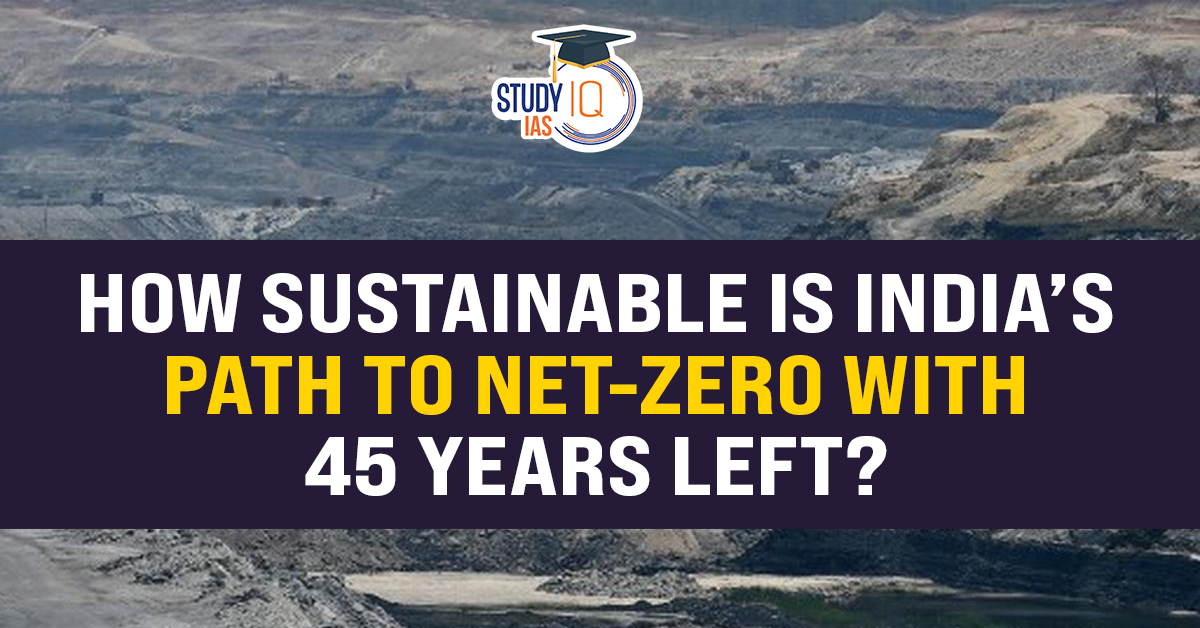Table of Contents
With 45 years remaining until India’s net-zero target of 2070, the journey ahead is challenging but not insurmountable.
| Remaining Carbon Budget and Global Warming Limits |
|
Current Scenario
- Commitment to Net-Zero by 2070: India has pledged to achieve net-zero carbon emissions by 2070. Policies to support this include:
- Expanding renewable energy capacity (currently ~70 GW solar and 47 GW wind).
- Electrification of energy use and investment in cleaner technologies.
- Focus on low per-capita emissions, among the lowest globally.
- Per Capita Emissions Disparity: The richest 10% of India’s population emit 20 times more CO₂ than the poorest 10%.
- Wealth disparity exacerbates climate inequity, with vulnerable groups facing severe impacts.
- Environmental Impact: Groundwater depletion, urban heat stress, biodiversity loss, and unsustainable land use are emerging threats due to unchecked consumption patterns.
- Power Demand Surge: India’s electrification ambitions could lead to a nine- to tenfold increase in energy demand by 2070, requiring over 5,500 GW of solar and 1,500 GW of wind capacity.
Key Hurdles
- Financial Challenges: Lack of adequate international financing, as developed nations have fallen short of their commitments. India needs substantial investments to fund renewable projects and climate adaptation.
- Resource Constraints: Limited land for renewable installations, forest cover preservation, and food security.
- Water scarcity affects agricultural sustainability and energy production.
- Technological Dependence: Inadequate access to advanced technologies for energy storage and efficiency improvements.
- Limited penetration of nuclear energy, which is crucial for balancing intermittent renewables.
- Lifestyle Aspirations and Urbanisation: Rising consumerism and lifestyle shifts are leading to higher energy and material demands.
- Urban sprawl and vehicular pollution add to heat stress and carbon emissions.
- Policy and Implementation Gaps: Delays in demand-side management and decentralisation of energy production.
- Weak enforcement of regulations for industrial and urban emissions.
What Can Be Done?
Demand-Side Measures
- Promote Energy Efficiency: Use energy-efficient appliances, passive design in construction, and better materials to reduce energy demand.
- Encourage non-motorised and public transport for urban and intercity travel.
- Conscious Consumption: Implement “sufficiency consumption corridors” with limits on excess consumption to avoid unsustainable growth.
- Promote local products and reduce dependence on long-haul freight.
- Dietary and Industrial Alternatives: Advocate for mindful dietary changes and alternative fuels in heavy industries.
- Electrify industries while gradually reducing coal dependence.
Supply-Side Measures
- Decentralised Energy Production: Expand rooftop solar and solar pumps for agriculture to reduce reliance on central grids.
- Diversify energy sources with nuclear power for low-carbon, baseload energy.
- Renewable Energy Expansion
- Achieve realistic renewable energy targets while ensuring land-use trade-offs are minimised.
- Use modelling to balance food security, biodiversity, and energy needs.
- Phase-Out Fossil Fuels: Gradual reduction of coal-based power plants, replacing them with renewable and nuclear sources.
Policy and Governance
- Climate Finance Mobilisation: Pressure developed countries to fulfill their financing commitments, ensuring that India can access affordable technology and funds.
- Create a domestic green finance framework to attract private investment.
- Education and Awareness: Promote environmental literacy to change consumption patterns and adopt sustainable practices.
- Global Collaboration: Advocate for equitable climate action at international forums like COP-29.
- Strengthen ties with nations leading in renewable energy innovation.


 Somaliland Explained: Location, History,...
Somaliland Explained: Location, History,...
 Signals from the Indian Economy: What Ke...
Signals from the Indian Economy: What Ke...
 Reforms Needed in India’s Political Fu...
Reforms Needed in India’s Political Fu...

























